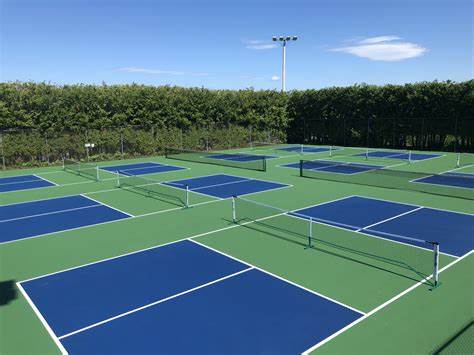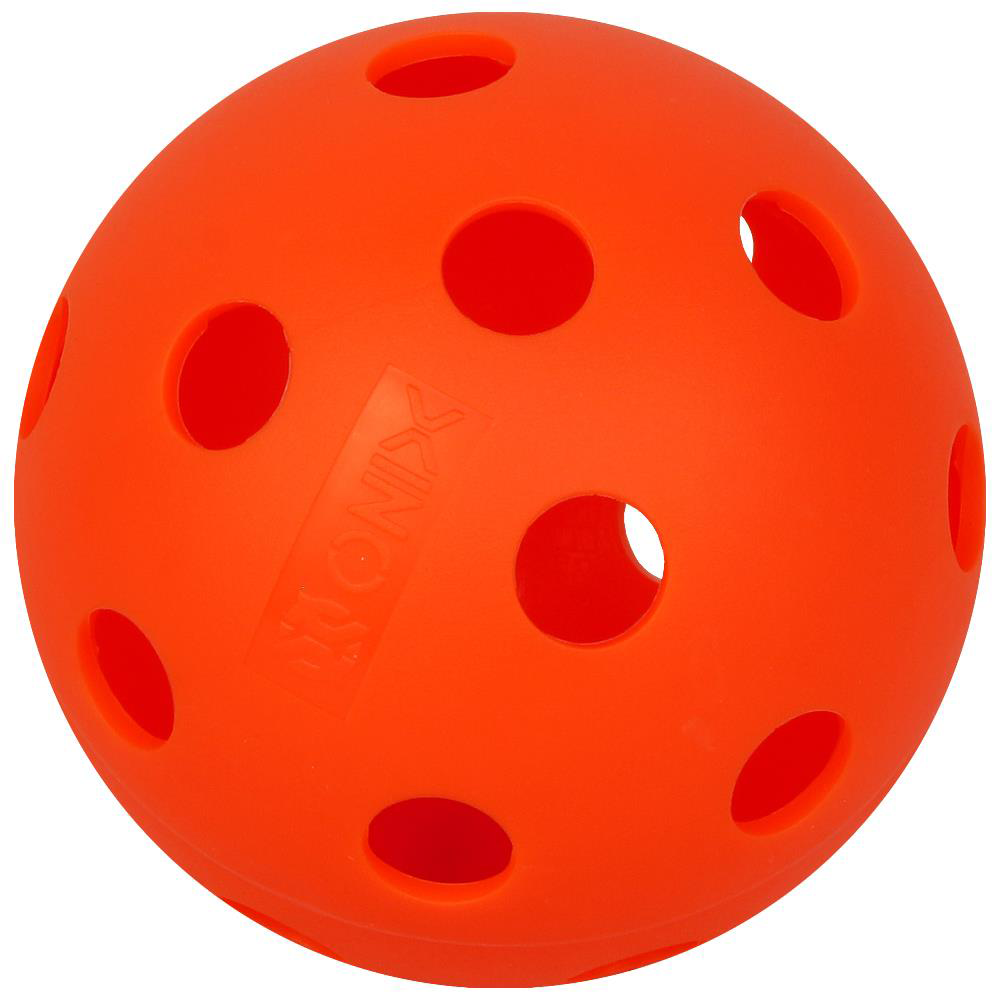Though physics wasn’t my favorite subject in school, I learned one essential principle: The Impeccable Law, which states that two like objects can’t occupy the same space at the same time. This makes me wonder—can Tennis and Pickleball coexist?
Although tennis and pickleball share some basic elements like a ball, net, court, and the use of a paddle or racket, they are actually quite different. The similarities stop at the equipment, as the players and playing styles in each sport are distinct.
Let’s look at the differences between the equipment.
- The Ball
- Pickleball balls have a predictable lower bounce while tennis balls go higher and are more variable. Pickleball balls are lighter and slightly bigger in diameter. Pickleball balls have holes, while tennis balls have fuzz. Tennis balls use felt/rubber, while pickleballs use plastic/polymer.
- The Net
- A pickleball net is thirty-six inches high at the side posts and thirty-four inches of height at the center. A tennis net is forty-two inches high at the side post and thirty-six inches in the center. The biggest difference is the width, Pickleball nets are only twenty-one feet nine inches wide, while tennis nets are forty-two feet wide.
- The Court
- A pickleball court is less than half the size of a tennis court. A pickleball court is twenty feet by forty-four feet while a tennis court is thirty-six feet by seventy-eight feet. On a side note, the U.S. Tennis Association says that 10% of tennis courts in America have been taken over or repainted since the pickleball boom began.
- The Paddle/Racket
- A pickleball paddle must not exceed twenty-four inches from the edge guard to the butt cap. Additionally, the paddle cannot exceed seventeen inches in length on its hitting surface. While there are no rules that govern the weight and thickness of a pickleball paddle, typically a pickleball paddle weighs between 7.5 and 8 ounces. A tennis racket cannot exceed twenty-nine inches in length and the stringed area of the racket must not exceed 15.5 inches in length and 11.5 inches in width. The typical weight of the tennis racket is around 10 to 11 ounces.
The Wall Street Journal recently published an article highlighting the struggle that exist between the sport of tennis and pickleball called: “The Turf War Between Tennis and Pickleball Is Escalating” (paywall). While the article highlights the growth of both pickleball and tennis and their competition for court space, it does not address the challenges tennis players face in adapting to pickleball play.
I have had the pleasure of playing with many skilled former tennis players. While some tennis players have successfully transitioned to proper pickleball techniques, old habits often persist. The information provided below is designed to help tennis players who are eager to dive into pickleball. Three of the main challenges tennis players face include mastering the Non-Volley Line (The Kitchen), managing power (avoiding the urge to consistently bang the ball), and refining their softer shots (dinking).
The Non-Volley (Kitchen) Line
The two non-volley zone areas that tennis players typically struggle with are getting to the kitchen line and executing proper play there.
Lingering longer at the baseline can and will cause frustration to tennis players. Skilled pickleball players know how to defend against this type of play as they will use softer drop shots in or around the kitchen line. Baseline (banging) shots are engrained into the tennis player. They feel comfortable there and most of them can execute great low powerful shots. Pickleball games are won and lost at the Kitchen Line, so it is extremely important to make your way there as quickly as possible.
A rule of thumb I teach during instruction is this, “Serve and Stay, Return and Run.”
Serve and Stay: The server (and their partner), once the ball is served, should stay at the baseline and wait for the ball to be returned. If the return is short, it is much easier and safer to move forward than backpaddle. Once you have made your third shot, you need to work your way to the kitchen.
Return and Run: The goal of the player returning the serve should be to return the ball deep and get (run) to the kitchen line prior to the ball being volleyed by the other team. Remember, your teammate is already there, and you need to be there also. All good pickleball players know the importance of making their way to the kitchen line as your chances of winning on the pickleball court go up once you are there.
Stay out of the Kitchen: Now that you are at the kitchen line, how do you stay out of it? Simple, know the rules and practice! The game of tennis does not have an area at the net designated as a non-volley zone. Tennis players often struggle with staying out of the kitchen as they are accustomed to volleying at the net. More rule infractions occur at the kitchen (non-Volley Zone) than any other. Even the best players often commit NVZ violations. The two rules that everyone should know are:
9.B. A fault will be declared if, in the act of volleying the ball, a player or anything the player is wearing or carrying touches the non-volley zone or touches any non-volley line. For example, a fault will be declared if, in the act of volleying the ball, one of the player’s feet touches a non-volley line.
9.C. A fault will be declared if, in the act of volleying the ball, the player’s momentum causes the player or anything the player is wearing or carrying to touch the non-volley zone or touch any non-volley line. It is a fault if the player’s momentum causes the player to touch anything that is touching the non-volley zone, including the player’s partner. It is a fault even if the ball is declared dead before the player touches the non-volley zone.
Check your feet: You have heard the saying, “It just takes practice,” well, it does. Be cognizant of where your feet are when at the NVZ. Until you have become comfortable playing at the NVZ, a quick visual check doesn’t hurt (but do not look too long). When using the ready position at the NVZ, your feet will always be directly under your torso which will also help you determine your location in relation to the NVZ line. Over time and with practice, this will become second nature to you.
Power
For most tennis players, power shots are their primary weapon of choice. However, when transitioning to pickleball, they may experience a conflict between power, accuracy, and finesse. This conflict stems from the ingrained tendency of tennis players to hit the ball with power. It is essential to learn to slow the ball down and be more strategic with your shots.
While a powerful down-the-line shot can be effective, a well-placed finesse shot can be just as impactful. Resist the urge to smash aggressive shots at the net; adopting a different strategy will increase your chances of winning. Although power shots can be useful in other areas of the court, the non-volley zone (NVZ) requires more emphasis on placement and patience. Instead of trying to overpower your opponent, focus on placing the ball in challenging spots within their kitchen area. This forces them to move and increases the likelihood of errors. Remember, power shots at the kitchen line will occur, but they should be the exception rather than the rule. Striking the right balance between power and finesse is essential, as both can lead to winning points. A true pickleball purist will always prioritize finesse over power.
Dinking
Dinking in Pickleball is usually uncomfortable and foreign to tennis players and is the area that typically needs the most focus and practice. Dinking is an essential skill in pickleball and is where strategy rules. It’s the part of the game where you win or lose points and games. So why is this part of the game so important?
- Control: Dinking helps you control the pace of the game and disrupt your opponent’s rhythm.
- Strategy: It forces your opponents to move forward, potentially making them vulnerable to mistakes.
- Patience: It encourages a strategic, patient approach rather than relying solely on power shots.
Truly, the only way to improve this skill and to become comfortable is practice.
When practicing your dinks, do not forget to:
- Be in the ready position.
- Grip your paddle loosely.
- Keep the ball low and just over the net.
- Use a locked wrist to guide the ball, keeping the motion controlled and gentle.
- After hitting a dink shot, return to the ready position.
- Watch your power, do not pop it up.
- Ensure you are not standing in the NVZ.
Finally, yes there are other areas that tennis players struggle with when transitioning to Pickleball. Here are a few:
- Lateral Movement – Pickleball has more lateral movement than tennis
- Reaction Time – The shorter court and the NVZ requires faster reaction time.
- Short Backswing – The paddle swings must be compact and shorter.
If you are a tennis player, beginner or someone looking to improve your game, and would like to work on some of the areas discussed, click on the pickleball image below to schedule your lessons.


